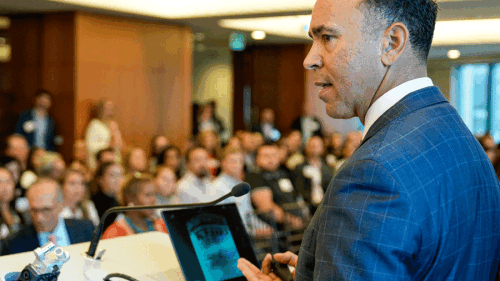Watch video interviews of
Leslie Braunstein , Evan Kraus and Sybil Walker Barnes , who offer their views on the current and future use of social media in commercial real estate from the perspectives of public relations firms, marketing consulting firms, and the design professionals community, respectively.
Social media and their return on investment for commercial real estate continue to pose a conundrum for companies and public relations professionals. While politicians, airlines, and some major retail chains have long found ways to successfully engage with audiences in order to increase exposure or improve sales, the land use industry continues to scratch its head when searching for ways to prove its place in real estate. However, the heyday for the land use industry and social media may be in 2011.
Companies like Starbucks and Southwest Airlines, whose social media success stories receive a lot of attention, continue to upgrade and innovate their social media campaigns while the real estate industry continues to play around with communication models from 2009. However, there have been some firms that have moved beyond simply establishing a social media presence and linking to company news. Today, some of the industry’s growing social media practices include the following: video- and photo-sharing by real estate pros, crowdsourcing and facilitating public involvement by urban planners, profiling a project by architecture firms, and experts establishing themselves as thought leaders within their industry. While these are still relevant and useful applications for social media, they are not necessarily helping firms make a buck.
Social Media and CRE: Past and Present
Earlier this month, CoStar published an article discussing how most commercial real estate companies currently manage their online presence. According to the article, even though few steps have been taken beyond basic property promotion and communicating company information, the consensus among real estate firms is that professionals are maintaining their social media presence in hopes that it will one day lead to more deals.
A recent Pew Research Center poll revealed that social media are now used by the majority of adult online users between the ages of 18 and 64, proving that social media have established their foothold in people’s online habits. Since the number of social media users continues to grow, it might not be wise to wait before deciding how to apply social media to companies’ business strategies.
Social media have already proven that they can be a powerful tool for both proponents and opponents of real estate development. In November 2010, the Wall Street Journal and nbcnewyork.com reported that homeowners in the Long Island town of Huntington organized an online campaign to oppose the development of a $100 million, 490-unit housing project. The development opponents effectively utilized social media sites like Facebook to successfully execute a communications campaign to fight the proposal of building new affordable homes within a half-mile of a Long Island Rail Road station. As a result of their efforts, the application submitted by AvalonBay Communities ended up being voted down by the Huntington town board.
Just as grass-roots NIMBY activists have harnessed the power of social media, so have some developers. Federal Realty Investment Trust leveraged the power of social media to earn public trust for its Montgomery County, Maryland, development project. The White Flint project formed a community outreach campaign that synthesized traditional and new media in order to motivate local citizens to attend public hearing and testify in favor of the development.
“We realized that we needed community building in order to help fix problems and to work with the community on a vision,” says Evan Goldman, ULI member and director of development with Federal Realty. “Where a typical developer generally avoids the media, our approach was the complete opposite. We felt like we had the right story and the only thing missing was education.”
Federal Realty’s communication campaign—which used a combination of Facebook, blog posts, and an interactive website—led to 400-plus pro-development letters being sent to the town board. Most importantly, Goldman and his team were able to amplify numerous voices of support from communities that had antidevelopment leadership.
Public relations professionals like ULI member Leslie Braunstein say that the messaging benefits of social media cannot afford to be passed up by any size professional in land use or real estate. She explains that real estate journalism, along with the entire news industry, is always in a scramble to cover a story before its competitors. According to Braunstein, social media provide real estate companies with a way to “outscoop” reporters by presenting the story first.
Braunstein says, “When you do this directly [through social media], you get to control the message and you get to present the story the way you want to present it. You don’t want to wait until someone else presents it for you and possibly makes it inaccurate and presents it in a way that you don’t want it presented.”
In addition to social media being a cheap and effective way of controlling a message, an advantage is its ability to not only make real estate and businesses more transparent, but also to make business more humanized and friendly. By promoting a company’s Facebook page, one can drive people to a more attractive arm of an official company website. Social media have the power to make people see a business without actually feeling like they are doing business. A company’s social media presence, if updated frequently, can actually receive more online visits than its official website. Companies like Coca-Cola and Starbucks have capitalized on their frequent Facebook page views by engaging visitors and updating their social media pages more than their official corporate websites.
The Future of Social Media and Land Use
Since social media are not going away anytime soon and likely to continue innovating, how can land use professionals capitalize on its offerings?
CREOPoint founder Jean-Claude Goldenstein, who founded the well-known commercial real estate social network in 2008, says there is not a clear-cut answer to how companies should use social media to meet financial goals.
“There’s no simple or single answer as to what to recommend to commercial real estate executives,” he said. “However, generally we often overestimate the short impact of internet technology while underestimating its long-term impact.”
He recommends that companies experiment with various online communities, listen and filter the commercial real estate online buzz, and anticipate how to adjust communication plans once mobile overtakes the desktop computer as the largest marketing channel. In addition, he recommends that firms identify the social media users who have the most influential voices and then intelligently engage them so that they talk about your company with the people who follow them.
Nick Shin, a social media specialist with Marketwire, says that companies will continue to experiment with social media, but many will also pull back from their usage if they do not see tangible results. Shin recommends that real estate companies develop a strategy, build online relationships through conversations, and be more than a mere presence by participating in Twitter chats, Facebook pages, and LinkedIn groups. He also advises real estate firms to go beyond Twitter, Facebook, and LinkedIn by creating an active presence on Foursquare, Yelp, and YouTube.
Other public relations experts like Braunstein and Evan Kraus, senior vice president of APCO Worldwide, see location-based or geo-marketing becoming more mainstream in the coming year as more consumers acquire GPS-enabled smartphones. This type of social networking—Foursquare being the most prominent of these websites—utilizes new technology in order to “geotag” users and connect with people in similar locations or share information.
“The biggest change for social media is going mobile,” says Braunstein. “Google found that there was a growth in the use of mobile search of 500 percent in the past two years.” She predicts that social networking websites like Foursquare, Facebook Places, Google Places, and Gowalla will continue to grow in active membership. “These apply very well to real estate because real estate is location based. Real estate is buildings, and buildings have a location,” she adds.
Foursquare, Gowalla Growth Mirrors Twitter’s Early Years
| According to a late 2010 poll, location based social media are being used by only 4% of the online population. However, the same report notes that Twitter, launched in July 2006, only had a 6% usage in August 2008. As more and more companies begin to capitalize on the marketing potential of location based services, like Foursquare and Gowalla, we may see a upsurge in these types of mobile services. |
Braunstein suggests several ways for real estate professionals to take advantage of this emergent technology. She recommends that building owners allow and encourage prospective tenants to check-in online with Foursquare. This not only builds customer relations, but it also helps brand a building or company since that person’s followers will see where they have been.
In addition, who is speaking will matter in 2011. Kraus and his company partnered with The Huffington Post to conduct focus groups with online influencers, asking what attributes of a company’s social media efforts are most effective in influencing the population at large. According to the Social EQ study, contrary to the traditional assumption that content is the most important factor in social media, the results of his study found that dialogue created by a person speaking on behalf of the company is the most critical. Kraus says that companies should make sure their chair is visible, employee ambassadors are active online, and that the company has solid relationships with major social media influencers.
“More thought should go into the collection of personalities that you are building to tell your story,” says Kraus. “Social media, like television is more so than print, are personality driven.” Companies like Apple Inc. have succeeded by placing their CEO, Steve Jobs, at the front of the company’s image. When companies are more transparent and put a face on their message, it has an online effect that can be “equal [to] or even higher than the importance of the literal content,” he adds.
Furthermore, Kraus sees the advent of 4G mobile technology transforming social media into a video-based platform. He predicts that as smartphones continue to develop faster processing speeds, video will become more important to a company’s online success and that ULI members should take note.
Is there a diminishing return with social media in real estate? It appears that the industry has struggled to fashion its place within its business operations, but that might be changing. Real estate communications and marketing professionals should take advantage of increased mobile bandwidth and create videos that tell a project’s story or ones that show how people interact with a particular development. In addition, firms should restructure their social media campaigns so that their company is more humanized. Marketers need to put a face on a company by attaching a company spokesperson to more external communiqués. Finally, if applicable, companies should try to incorporate location-based social networking into their overall communications strategy. Real estate is about buildings and geography, so Foursquare might be the social media breakthrough that land use professionals have been waiting for.
Real estate marketers should not jump ship on social media just yet. Social media glory has come and gone with small businesses and retail; however, recent technological advances hint that real estate may just be entering its time in the sun.
Please take a minute to complete ULI’s short Social Media and CRE Survey and help us better understand how you use social media.




